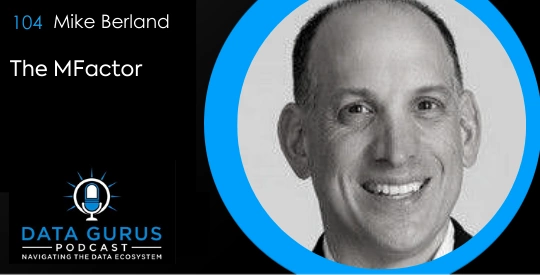Podcast: Play in new window | Download
We’re delighted to have Mike Berland, the CEO, and founder of Decode_M, joining us on the show today.
Mike is with us today to talk about data collection, analytics, and momentum.
About Mike
We currently live in a world that runs on data, and Mike holds the belief that everything is knowable, as long as you know where to look.
Mike is the former chair of the Gotham Chapter of the New York City Young Presidents’ Organization (YPO), and he is a Commonwealth Scholar from the University of Massachusetts. He has worked with many leading brands, including Airbnb, Lyft, Nike, Microsoft, Facebook, Estée Lauder Companies, National Hockey League, and Major League Baseball.
Mike has written three books. In 2009 he released a book that he co-authored with Doug Schoen, titled What Makes You Tick? How Successful People Do It and What You Can Learn from Them. Then, in 2005, he co-authored the number one bestseller, Fat-Burning Machine: The 12-Week Diet, with former Olympic triathlon coach Gale Bernhard. And he has now written a new book called Maximum Momentum: How to Build it and How to Keep It, which got released in January 2020.
Mike has two adult children, and he lives in Manhattan, New York, with his wife of more than twenty-five years.
About Decode_M
Decode_M is a research, analytics, and insights firm that decodes data into momentum for its clients. It is a fast-moving firm that arms its clients with the actionable information they need to make critical decisions.
As a team of passionate problem-solvers and data-driven storytellers, they use a diverse mix of data sets to identify the right answers and solutions so that their clients can take the right action immediately, with confidence.
Collecting & analyzing the right data is where the job starts for the Decode_M team. Strategy, activation, and how the data gets used is what they are all about.
Why Mike started Decode_M
Mike started Decode_M because he felt that there was another analytical tool needed in the data research and analytics space.
The most important question
When he started his career as a pollster, Mike asked questions, and he received answers. However, the answers were always limited to the data set. And Mike explains that when you’re a pollster, the most important questions are usually the ones you did not ask. So when you get the data and analyze it, you often realize that there are many other things that you wish that you had asked.
Going beyond polling
Over time, more and more data started becoming available, so Mike wanted to go beyond polling. He wanted to start analyzing all the data that was out there, using a new approach, new concepts, and new tools.
New ways of gathering data fast
In the old days, Mike had to call people on the phone and ask them questions to obtain the data that he needed.
Now that he has a computer and cloud computing, he can process as much data as any top research lab in a matter of hours. And he can now also continuously go back to the social media data, or the behavioral data, rewrite the queries and keep building.
Completing a project
Before, with surveys, the project was complete once the report had been presented. Now, with Decode_M’s current analytics, the project is never really done because the data can continue to get mined.
Momentum
Mike wrote a book called Maximum Momentum, with the idea that momentum is an amorphous word that may work in many different and varied contexts, and he wanted to quantify momentum.
The M-Factor
In physics, momentum equals mass times velocity. So Mike had to create the metrics from mass and velocity and then put them together to create what he calls the M-Factor.
Mike explains that the mass is the volume of conversation, and the velocity is the engagement and the sentiment.
How the market was getting things wrong
Mike thought that the market was getting things wrong because all the metrics for social media were volume metrics, as in how many likes or re-tweets they were getting, and he felt that none of that meant anything. Yet all his clients were asking for something that would go so fast that everyone would look at it.
Mike then realized that although people were looking for a mass metric, what they needed was a velocity metric. And, at the time, there were no metrics available to measure velocity.
Creating algorithms to examine velocity
Mike and his team had to write their algorithms to work out how velocity could be measured. So they used state-of-the-art natural language processing with sentiment analysis to create their velocity algorithms. They came up with the drivers of momentum, which were disruption, polarization, stickiness, and social impact, all of which had to be in the velocity to create momentum.
And that, ultimately, has been the key to their success.
Links:
Decode_M on Instagram (@decode_momentum)
———————————–
Email me your thoughts!
Sima is passionate about data and loves to share, learn, and help others that share that passion. If you love data as much as her, subscribe on iTunes and don’t forget to leave a rating and review!




